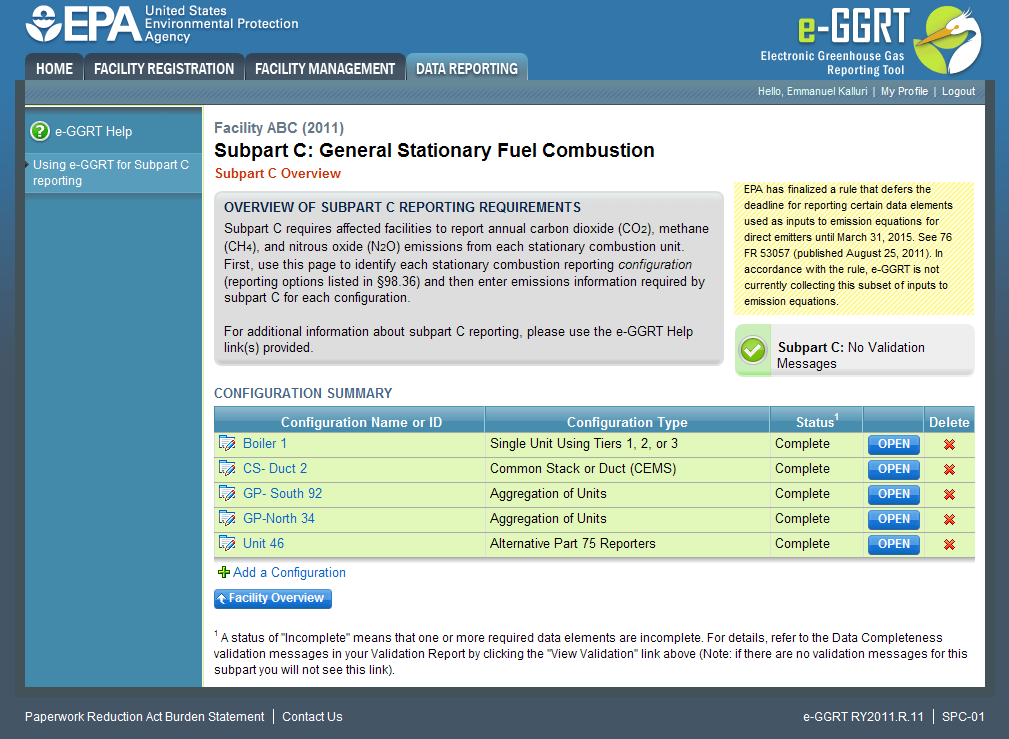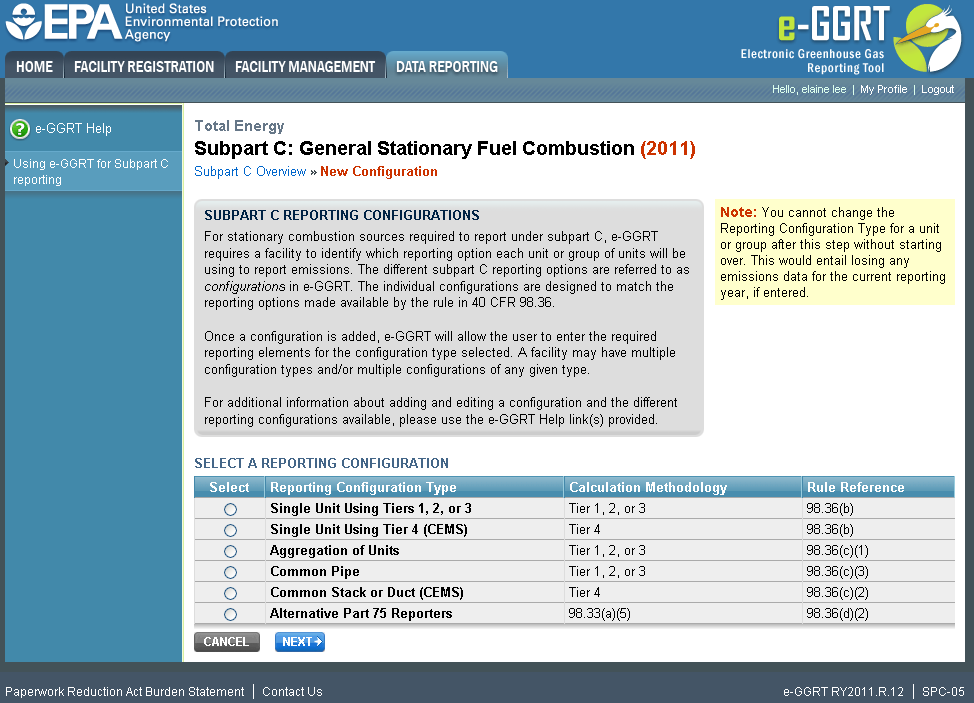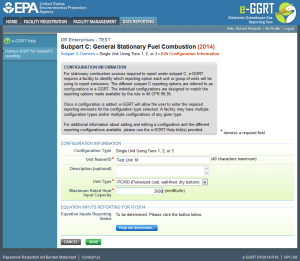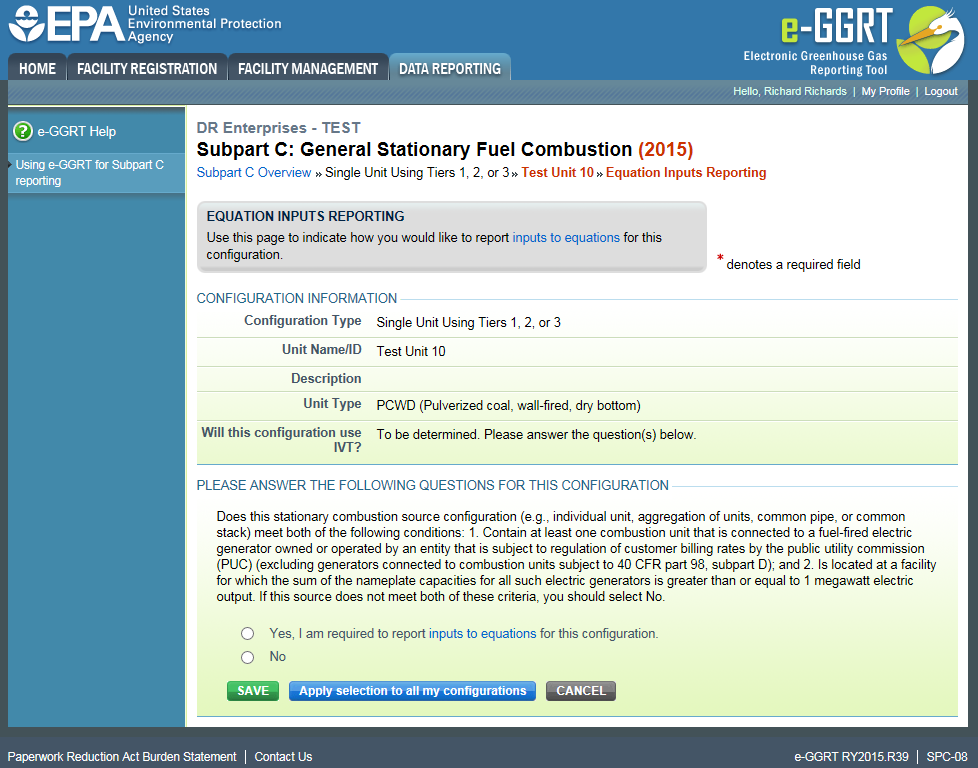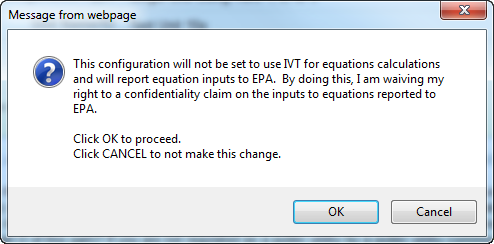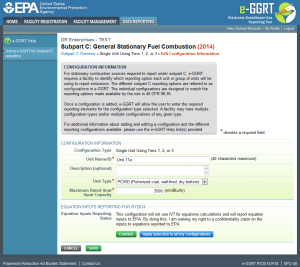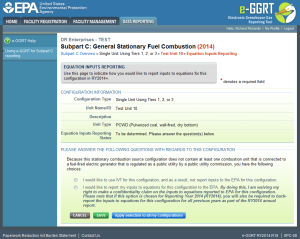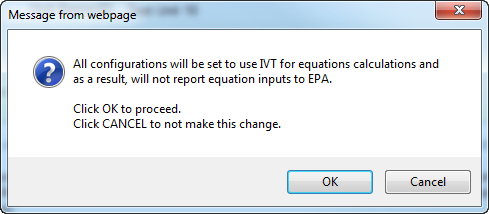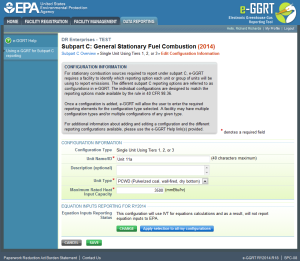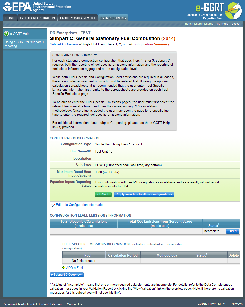This topic provides a step-by-step description of how to add a subpart C Stationary Fuel Combustion Sources configuration for a facility.
Click this link to expand
Adding Configurations
Starting on the Subpart C Overview page, click the link titled "ADD a Configuration" below the CONFIGURATION SUMMARY table.
Click this link to expand
The unit or group configuration types are first briefly identified below with the relevant regulatory citation, and then again in more detail:
- Configuration Type 1 - A single unit using Tiers 1, 2 or 3 to calculate emissions [98.36(b)]
- Configuration Type 2 - A single unit using Tier 4 (CEMS) to calculate emissions [98.36(b)]
- Configuration Type 3 - A group of units using the aggregation of units reporting alternative [98.36(c)(1)]
- Configuration Type 4 - A group of units using the common pipe configuration reporting alternative [98.36(c)(3)]
- Configuration Type 5 - A group of units using Tier 4 (CEMS) to calculate emissions and reporting under the monitored common stack or duct configuration reporting alternative [98.36(c)(2)]
- Configuration Type 6 – Part 75 units using the alternative CO2 mass emissions calculation methods provided in 98.33(a)(5) [98.36(d)(2)]
Configuration Type 1 - Single Unit Using Tiers 1, 2, or 3 [98.36(b)]
The single unit reporting configuration is the most basic configuration type. Any unit may be reported individually in e-GGRT. If the unit uses Tiers 1, 2, or 3 to calculate CO2 emissions, Configuration Type 1 must be used.
A unit under Configuration Type 1 may combust multiple fuels, and it is possible for each fuel to use a different tier. For example, a unit that has a maximum rated heat input capacity of 500 mmBtu/hr is generally required to use Tier 3 for coal, but may use Tier 1 or Tier 2 for natural gas.
Configuration Type 2 – Single Unit Using Tier 4 [98.36(b)]
Configuration Type 2 is the reporting option for a single unit that is either required, or elects to use Tier 4 (CEMS). CO2 emissions are reported for all fuels combined, but CH4 and N2O emissions are reported individually for each fuel.
If a unit changes its calculation methodology to Tier 4 during the year, the unit will need to be added as two separate configurations in e-GGRT with different configuration names.
Configuration Type 3 – Aggregation of Units [98.36(c)(1)]
The aggregation of units option is a reporting configuration that allows multiple units to be reported as a single entity, provided that certain conditions are met. If this reporting option is selected, emissions from all of the units grouped in this configuration will be reported as combined emissions in e-GGRT.
If a facility contains two or more units, each of which has a maximum rated heat input capacity of 250 mmBtu/hr or less, you may report these units as a Configuration Type 3 in e-GGRT, provided that only Tiers 1-3 are used and the units use the same tier for any common fuels combusted. Fuels of different types may use different tiers, as permitted. There is no limit on the number of units that may be included in this configuration provided the previous criteria are met.
While the use of Tier 3 is permitted in an aggregation of units configuration, it is not common for configurations of this type as Tier 3 is generally required only for larger units (i.e., greater than 250 mmBtu/hr) that are not eligible for the aggregation of units reporting option.
Configuration Type 4 – Common Pipe [98.36(c)(3)]
The common pipe reporting configuration is another alternative reporting option that allows for multiple units to be reported as a single group entry.
This configuration is different from the aggregation of units configuration in that there is no size constraint. The common pipe configuration may only be used if two or more stationary combustion units at a facility combust the same type of liquid or gaseous fuel and the fuel is fed to the individual units through a common supply line or pipe.
The common pipe configuration may only be used if the units only combust the liquid or gaseous fuel supplied by the common pipe. Units that combust fuel other than the fuel supplied by the common pipe must be accounted for under a separate configuration since a single unit may not be reported under multiple configurations. For example, a unit that burns coal and natural gas may not be included in a common pipe configuration for units that only combust natural gas. In such a situation, you may report the units that only combust natural gas as a common pipe configuration and report the unit that combusts coal and natural gas under a separate configuration. To calculate emissions for the common pipe, you may use company records to subtract the quantity of gas diverted to the gas/coal unit from the quantity of gas measured for the common pipe. The diverted gas would need to be accounted for in a separate configuration for the coal/gas-fired unit. If the gas was diverted offsite or to an exempt unit, then it would not have to be accounted for in the facility’s annual GHG report and may also be subtracted, using company records, from the fuel measured for the common pipe.
The tier required for the common pipe configuration is based on the maximum rated heat input capacity of the largest unit served by the common pipe.
Configuration Type 5 – Common Stack [98.36(c)(2)]
If multiple units vent to a common stack or duct and Tier 4 is used to calculate the CO2 emissions for those units, the common stack configuration must be used.
Configuration Type 6 – Alternative Part 75 Reporters [98.36(d)(2)]
This configuration represents the alternative calculation and reporting requirements available to certain units that report heat input year-round to EPA according to part 75. Units subject to subpart D (electricity generating units that are subject to the Acid Rain Program or EGUs that are otherwise required to monitor and report to EPA CO2 emissions year-round according to Part 75) are not be eligible to report under this option. Units subject to subpart D should report following the instructions for subpart D.
If this option is selected in place of using one of the 4 tiers, the applicable calculation methodology specified in 98.33(a)(5) must be used to calculate CO2 emissions and the reporting requirements specified in 98.36(d)(2) replace the requirements specified in 98.36(b).
Use the radio buttons to select a configuration type.
When finished, click NEXT.
The next screen will vary slightly depending on the configuration type selected.
Click this link to expand
Entering Configuration Information
Once a configuration is added, you will be prompted to input information that will serve to identify the configuration. The identification elements are listed below for each configuration type:
For configurations of Type 1 (single unit using Tiers 1, 2, or 3) , subpart C requires the following configuration-level information:
- A unique unit name or identifier (e.g., a unit ID number) [98.36(b)(1)]
- Alphanumeric and special characters may be use other than commas and quotes (no , ' or " )
- An optional description or label [optional]
- A code representing the type of unit [98.36(b)(2)]
- If the unit type is not provided in the given pick list, the user should select the type “OCS (Other combustion source)” and specify an appropriate unit type in the free text field
- The value of the maximum rated heat input capacity of the unit in mmBtu/hr [98.36(b)(3)]
- If applicable, the plant code (as defined in 98.6) [98.36(b)(11)] Note that this field will not appear unless the reporter indicates in Subpart A that they will be reporting plant codes in Subpart C. A plant code is the Plant ID code assigned by the Department of Energy's (DOE) Energy Information Administration (EIA) and may also be referred to as the "ORIS code", "ORISPL code", "Facility ID", or "Facility code", among other names. If a plant code has not been assigned by DOE's EIA, then plant code means a code beginning with "88" assigned by EPA's Clean Air Markets Division (CAMD) for electronic reporting. If you have more than one plant code to report for this configuration, separate each code with a comma. In most cases, the same plant code will apply to each reporting configuration at the facility. However, one facility reporting under the GHGRP may have multiple plant codes that apply to different configurations because of differences between the part 98 definition of "facility" and the conventions used by EIA to assign plant codes. Note that if a plant code is entered, it will appear alongside the configuration information that is displayed on the Subpart C Overview Page.
For configurations of Type 2 (single unit using Tier 4) , subpart C requires the following information for each configuration:
- A unique unit name or identifier (e.g., a unit ID number) [98.36(b)(1)]
- Alphanumeric and special characters may be used except for commas and quotes (no , ' or " )
- An optional description or label [optional]
- A code representing the type of unit [98.36(b)(2)]
- The value of the maximum rated heat input capacity of the unit in mmBtu/hr [98.36(b)(3)]
- The methodology start date and end date, for the unit [98.36(b)(6)-(7)]
- If applicable, the plant code (as defined in 98.6) [98.36(b)(11)] Note that this field will not appear unless the reporter indicates in Subpart A that they will be reporting plant codes in Subpart C. A plant code is the Plant ID code assigned by the Department of Energy's (DOE) Energy Information Administration (EIA) and may also be referred to as the "ORIS code", "ORISPL code", "Facility ID", or "Facility code", among other names. If a plant code has not been assigned by DOE's EIA, then plant code means a code beginning with "88" assigned by EPA's Clean Air Markets Division (CAMD) for electronic reporting. If you have more than one plant code to report for this configuration, separate each code with a comma. In most cases, the same plant code will apply to each reporting configuration at the facility. However, one facility reporting under the GHGRP may have multiple plant codes that apply to different configurations because of differences between the part 98 definition of "facility" and the conventions used by EIA to assign plant codes. Note that if a plant code is entered, it will appear alongside the configuration information that is displayed on the Subpart C Overview Page.
For configurations of Type 3 (aggregation of units) , subpart C requires the following configuration-level information:
- A unique name or identifier that begins with the prefix “GP” [98.36(c)(1)(i)]
- Alphanumeric and special characters may be used except for commas and quotes (no , ' or " )
- An optional description or label [optional]
- The highest maximum rated heat input capacity of any unit in the group in mmBtu/hr [98.36(c)(1)(iv)]
The Cumulative Maximum Rated Heat Input Capacity of for all units within the configuration that have a maximum rated heat input capacity greater than or equal to 10mmBtu/hr
If applicable, the plant code (as defined in 98.6) [98.36(c)(1)(xi)] Note that this field will not appear unless the reporter indicates in Subpart A that they will be reporting plant codes in Subpart C. A plant code is the Plant ID code assigned by the Department of Energy's (DOE) Energy Information Administration (EIA) and may also be referred to as the "ORIS code", "ORISPL code", "Facility ID", or "Facility code", among other names. If a plant code has not been assigned by DOE's EIA, then plant code means a code beginning with "88" assigned by EPA's Clean Air Markets Division (CAMD) for electronic reporting. If you have more than one plant code to report for this configuration, separate each code with a comma. In most cases, the same plant code will apply to each reporting configuration at the facility. However, one facility reporting under the GHGRP may have multiple plant codes that apply to different configurations because of differences between the part 98 definition of "facility" and the conventions used by EIA to assign plant codes. Note that if a plant code is entered, it will appear alongside the configuration information that is displayed on the Subpart C Overview Page.
For configurations of Type 4 (common pipe configurations) , subpart C requires the following information for each configuration:
- A unique name or identifier that begins with the prefix “CP” [98.36(c)(3)(i)]
- Alphanumeric and special characters may be used except for commas and quotes (no , ' or " )
- An optional description or label [optional]
- The highest maximum rated heat input capacity of any unit served by the common pipe in mmBtu/hr [98.36(c)(3)(iii)]
- The Cumulative Maximum Rated Heat Input Capacity of for all units within the configuration that have a maximum rated heat input capacity greater than or equal to 10mmBtu/hr
- If applicable, the plant code (as defined in 98.6) [98.36(c)(3)(x)]. Note that this field will not appear unless the reporter indicates in Subpart A that they will be reporting plant codes in Subpart C. A plant code is the Plant ID code assigned by the Department of Energy's (DOE) Energy Information Administration (EIA) and may also be referred to as the "ORIS code", "ORISPL code", "Facility ID", or "Facility code", among other names. If a plant code has not been assigned by DOE's EIA, then plant code means a code beginning with "88" assigned by EPA's Clean Air Markets Division (CAMD) for electronic reporting. Note that if a plant code is entered, it will appear alongside the configuration information that is displayed on the Subpart C Overview Page.
For configurations of Type 5 (monitored common stack or duct configurations) , subpart C requires the following identification information for each configuration:
- A unique name or identifier that begins with the prefix “CS” [98.36(c)(2)(i)]
- Alphanumeric and special characters may be used except for commas and quotes (no , ' or " )
- An optional description or label [optional]
- The number of units sharing the common stack [98.36(c)(2)(ii)]
- The combined maximum rated heat input capacity of the units sharing the common stack in mmBtu/hr [98.36(c)(2)(iii)]
- The methodology start date and end date, for the configuration [98.36(c)(2)(vi)-(vii)]
- If applicable, the plant code (as defined in 98.6) [98.36(c)(2)(xi)] Note that this field will not appear unless the reporter indicates in Subpart A that they will be reporting plant codes in Subpart C. A plant code is the Plant ID code assigned by the Department of Energy's (DOE) Energy Information Administration (EIA) and may also be referred to as the "ORIS code", "ORISPL code", "Facility ID", or "Facility code", among other names. If a plant code has not been assigned by DOE's EIA, then plant code means a code beginning with "88" assigned by EPA's Clean Air Markets Division (CAMD) for electronic reporting. If you have more than one plant code to report for this configuration, separate each code with a comma. In most cases, the same plant code will apply to each reporting configuration at the facility. However, one facility reporting under the GHGRP may have multiple plant codes that apply to different configurations because of differences between the part 98 definition of "facility" and the conventions used by EIA to assign plant codes. Note that if a plant code is entered, it will appear alongside the configuration information that is displayed on the Subpart C Overview Page.
For configurations of Type 6 (year-round Part 75 heat input reporters) , subpart C requires the following information for each configuration:
- Unit, stack, or pipe ID numbers: use exact same unit, common stack, common pipe, or multiple stack identification numbers that represent the monitored locations (e.g., 1, 2, CS001, MS1A, CP001, etc.) that are reported under 40 CFR 75.64 [98.36(d)(2)(i)]
- Alphanumeric and special characters may be used except for commas and quotes (no , ' or " )
- An optional description or label [optional]
- The Part 75 methodology used to calculate the CO2 mass emissions (Appendix D and G calculation method, Low Mass Emissions calculation method in 40 CFR 75.19, or CEMS calculation method) [98.36(d)(2)(ii)(B), 98.36(d)(2)(iii)(B)]
- An indication of the Part 75 heat input method used (Appendix D method, Low Mass Emissions calculation method in 40 CFR 75.19, or CEMS calculation method) [98.36(d)(2)(ii)(E), 98.36(d)(2)(iii)(E)]
- The methodology start date and end date [98.36(d)(2)(ii)(C)-(D)]
- If applicable, the plant code (as defined in 98.6) [98.36(d)(2)(ii)(J), 98.36(d)(2)(iii)(J)] Note that this field will not appear unless the reporter indicates in Subpart A that they will be reporting plant codes in Subpart C. A plant code is the Plant ID code assigned by the Department of Energy's (DOE) Energy Information Administration (EIA) and may also be referred to as the "ORIS code", "ORISPL code", "Facility ID", or "Facility code", among other names. If a plant code has not been assigned by DOE's EIA, then plant code means a code beginning with "88" assigned by EPA's Clean Air Markets Division (CAMD) for electronic reporting. If you have more than one plant code to report for this configuration, separate each code with a comma. In most cases, the same plant code will apply to each reporting configuration at the facility. However, one facility reporting under the GHGRP may have multiple plant codes that apply to different configurations because of differences between the part 98 definition of "facility" and the conventions used by EIA to assign plant codes. Note that if a plant code is entered, it will appear alongside the configuration information that is displayed on the Subpart C Overview Page.
Use the text boxes and drop-down menus to enter the required information for the configuration type selected.
Identifying Equations Inputs Reporting Status
Beginning in RY2014, the Edit Configuration Information page includes a section for determining whether or not equation inputs for subpart C will be entered using the Inputs Verifier Tool (IVT). In the EQUATION INPUTS REPORTING FOR RY2014 section, click on the "Help Me Determine..." button to open the questions that help you determine how you should enter or report equation inputs.
Use the “Yes” or “No” radio buttons to answer the first question, which asks whether the stationary combustion source configuration meets both of the following conditions: 1) Contain at least one combustion Unit that is connected to a fuel-fired electric generator owned or operated by an entity that is subject to regulation of customer billing rates by the public utility commission (PUC) (excluding generators connected to combustion units subject to 40 CFR part 98, subpart D); and 2) Is located at a facility for which the sum of the nameplate capacities for all such electric generators is greater than or equal to 1 megawatt electric output. If this source does not meet both of these criteria, you should select “No.” If the user chooses “No”
Clicking on OK will return you to the Edit Configuration Information page, where the equation inputs reporting status you selected will be displayed in the EQUATION INPUTS REPORTING FOR RY2014 section:
Click this link to expand
Clicking "Save" again will take you to the Configuration Summary page where you can initiate reporting of configuration-level and fuel-level emissions for the configuration.
If your configuration does not meet the requirement to report equation inputs, select the "No" radio button on the Equation Inputs Reporting page." This action will take you to the second question shown in the screen shot below:
Click this link to expand
If your configuration does not meet the requirement to report equation inputs, you can choose whether to avoid reporting equation inputs to EPA by entering them into the IVT or to report equation inputs to EPA and waive your right to make a confidentiality claim on these inputs. Use the radio buttons to choose between the following options:
- I would like to use IVT for this configuration, and as a result, not report inputs to the EPA for this configuration.
- I would like to report my inputs to equations for this configuration to the EPA. By doing this, I am waiving my right to make a confidentiality claim on the inputs to equations reported to EPA for this configuration. Please note that if this option is chosen for Reporting Year 2014 (RY2014), you will also be required to back-report the inputs to equations for this configuration for all previous years as part of the RY2014 annual report.
After making your choice, click on either "Save" or "Apply selection to all my configurations." If you elected to use IVT, this action will activate a pop-up like the one shown below asking you to confirm your choice.
Click OK to return to the Edit Configuration Information, where the equation inputs reporting status you selected will be displayed in the EQUATION INPUTS REPORTING FOR RY2017 section:
Click this link to expand
If you elect not to use the IVT and report equations inputs, selecting the radio button labeled "I would like to report my inputs to equations for this configuration to the EPA" on the Equations Inputs Reporting page will take you to the following question:
You have indicated that you are waiving your right to making a confidentiality claim for the inputs to equations reported to the EPA for this configuration. Would you like to proceed with reporting these inputs to equations or would you like to return to the previous question?
You can respond to this question by selecting one of the following radio buttons:
- Proceed with reporting my input to the EPA.
- Return to the previous question.
If you confirm your intention to report equation inputs for this configuration, a pop-up will ask you again to confirm this choice. Clicking on OK will return you to the Edit Configuration page where the equation inputs reporting status you selected will be displayed in the EQUATION INPUTS REPORTING FOR RY2014 section.
Clicking the SAVE button on the Edit Configuration Information page will take you to the Configuration Summary Page where you can initiate reporting of configuration-level and fuel-level emissions for the configuration.
Click this link to expand
Editing Configuration Information
To edit an existing configuration, click on the Subpart C Overview button on the Edit Configuration Information page and click on the edit icon or the Configuration Name or ID link in the first column of the CONFIGURATION SUMMARY table on the Subpart C Overview page.
To delete an existing configuration, click on the delete icon in the last column of the CONFIGURATION SUMMARY table.
Click this link to expand
See Also
Screen Errors
Using e-GGRT to Prepare Your Subpart C Report for RY2014 and Later
Subpart C Configurations for RY2014 and Later
Subpart C Configuration-Level Emissions Information for RY2014 and Later
Subpart C Fuel Identification Information for All Reporting Years
Subpart C Fuel-Level Emissions Information for RY2014 and Later
Configuration types, emission details and their presentation in the summary report
Using Subpart C Calculation Spreadsheets
Subpart Validation Report


